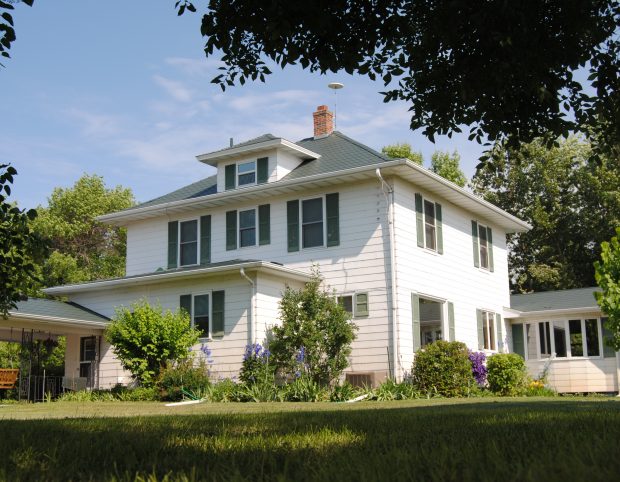When storm clouds roll in, they often bring more than just rain and hail—they invite a wave of opportunistic storm chasers hoping to cash in on homeowners’ misfortunes. These transient contractors, often called “storm chasers,” follow severe weather, offering quick fixes and big promises that often leave homeowners worse off. We’ll help you recognize the warning signs of roofing scams and understand why hiring a trusted local roofer is a smarter, safer choice.
Roofing Scams To Watch Out For This Storm Season
Door-to-Door High-Pressure Sales Tactics
What Happens:
After a big storm, you hear a knock on your door. A contractor in a high-visibility vest claims they’re “working on roofs in the area” and noticed storm damage to your home. They might even show you photos of damage—real or faked—and push for an immediate inspection or contract signing.
Red Flags:
- They initiate contact without your request.
- They use urgency or fear (“You need to act fast or you’ll miss your insurance window”).
- They don’t provide ID or credentials.
What to Do:
Always verify their license and insurance, and never agree to inspections or sign anything on the spot. A reputable contractor will never pressure you.
Fake or Inflated Damage Reports
What Happens:
Some storm chasers offer a “free roof inspection” but arrive with the intention of finding—or even creating—damage. There have been cases where scam artists use tools to dent shingles or lift tabs to simulate hail or wind damage.
Red Flags:
- The “damage” they point out is not visible from the ground.
- They refuse to let you or another inspector review the roof independently.
- They discourage you from calling your insurance first.
What to Do:
Ask for photo evidence and get a second opinion from a roofer you contact on your own. Never let a stranger climb onto your roof without verification.
Insurance Deductible Forgiveness or Manipulation
What Happens:
Storm chasers may offer to “cover your deductible” or falsify the invoice to make it seem higher than it is, pocketing the difference or giving you a kickback.
Why It’s Dangerous:
This is insurance fraud, plain and simple. If caught, you—not the contractor—are liable, which could lead to denied claims or even legal charges.
Red Flags:
- They offer deals that sound “too good to be true.”
- They ask you to sign over rights to handle your claim (Assignment of Benefits).
- They won’t provide a written estimate that matches the insurance adjuster’s report.
What to Do:
Insist on transparency and ask your insurance company to recommend reputable local contractors if needed.
Contracts With Hidden or Misleading Terms
What Happens:
Some storm chasers use generic or vague contracts filled with fine print that favors them. In many cases, the contracts bind homeowners into exclusive agreements, allow them to charge for “cancellation fees,” or even act on your behalf with your insurance company without your full knowledge.
Red Flags:
- The contract has a lot of small print or legal jargon.
- You’re told you must sign immediately to secure service.
- It gives the contractor permission to negotiate directly with your insurer.
What to Do:
Never sign a contract without reading it thoroughly. Have a lawyer or insurance agent review it if you’re unsure.
Upfront Payment and Disappearing Acts
What Happens:
Storm chasers may ask for a large down payment (often 50% or more) to “secure materials” or “hold your spot.” After receiving the funds, they vanish without doing any work—or deliver substandard results and leave before completion.
Red Flags:
- They request cash payments or wire transfers.
- They won’t provide a physical office address.
- They’re unwilling to offer a payment schedule tied to milestones.
What to Do:
Never pay more than 10-20% upfront, and only to a licensed contractor with a verifiable business. Payments should be tied to progress, not promises.
Out-of-Area “Locals”
Some storm chasers rent a local address or buy a temporary phone number to appear legitimate. They may even claim they’re “partnering” with a known roofer—who turns out to be unaware of the connection or nonexistent.
Red Flags:
- Their business license doesn’t match the address.
- They have no online reviews or only recent ones.
- Their truck is unmarked or lacks local branding.
What to Do:
Search their business name on Google, check for a physical presence in your community, and ask how long they’ve operated locally. If you can’t find them before the storm, don’t trust them after it.
Why Local Roofers Are the Smarter Choice
Reputation and Roots
Local roofers rely on community reputation. You can verify our credentials, check reviews, and see our previous work first-hand. We are invested in your satisfaction—not just a quick paycheck. When we run into our past clients at the grocery store, we want them to be happy to see us!
Licensed, Insured, and Certified
Reputable local roofers carry the proper licensing and insurance required by your state. Many of us are also certified by the manufacturers of the products we use, which adds an extra layer of accountability and extended warranties. At ABC Seamless of Nebraska, your steel roof comes with a lifetime, non-prorated, transferable warranty for your peace of mind.
Accessible Customer Service
A local roofer is just a phone call away if any issues arise or if you have any questions. Whether it’s warranty work or future repairs, you won’t be left in the lurch. We prioritize communication at ABC Seamless Of Nebraska, so you’ll be involved every step of the way before, during, and after.
Familiar with Local Code and Climate
Local contractors understand regional building codes, permit requirements, and the specific weather challenges your home may face. That expertise translates into better protection and longer-lasting results.
Storm Season Prep: Proactive Steps to Protect Your Roof
Before storm season kicks into high gear, a little preparation can go a long way in protecting your home and preventing costly damage. We’ve put together a little checklist to help you prepare:
Schedule a Professional Roof Inspection:
Have a licensed local roofer check for existing wear, loose shingles, or weak spots that could become entry points for water.
Clean Gutters and Downspouts:
Clogged gutters can cause water backup and roof rot. Ensure proper drainage by clearing debris now.
Trim Overhanging Branches:
Remove or trim back limbs that could fall on your roof during high winds.
Check Your Attic and Insulation:
A poorly ventilated attic can lead to moisture buildup. Look for signs of leaks or mold and add insulation if needed.
Document Your Roof’s Condition:
Take photos of your roof before storm season starts. This documentation can be very helpful if you need to file an insurance claim later.
Review Your Homeowner’s Insurance Policy:
Make sure you understand what your policy covers and whether you need additional coverage for wind or hail.
Top Roofers In Omaha, Lincoln, & Grand Island
Storm chasers talk a big game, but they often leave behind even bigger problems. Trust a local roofing expert who takes pride in their work. ABC Seamless Of Nebraska has been an active member of the community for over 40 years, bringing the highest quality products to homeowners that have the peace of mind knowing they are working with a reputable company. If your roof is in need of repairs or replacement, don’t wait until storm season forces your hand! Call or go online today to schedule your inspection and get a free quote.




